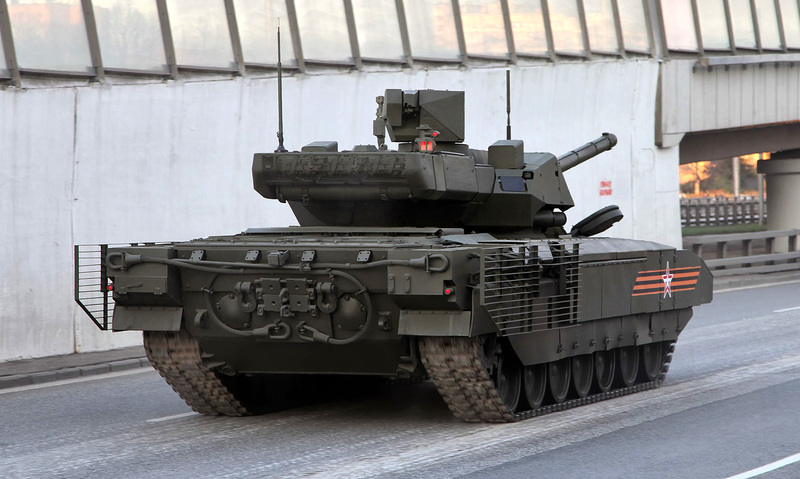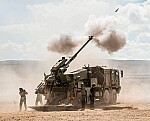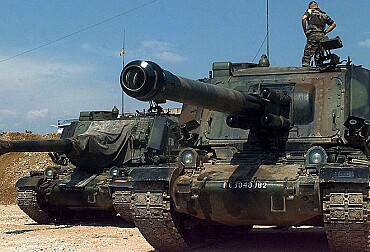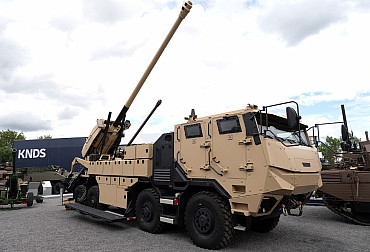Where are the T-14s Armata, Russia's most advanced MBTs? – Several months of complete silence
In spring 2023 there were rumours about Moscow deploying its first T-14 tanks, the "miracles" of Russian technology, on the Ukrainian battlefield. Later, these tanks were supposedly sent back to the factory to be improved using data gathered in combat. And there is a complete silence around them ever since.
The war in Ukraine is a veritable open-air laboratory for the Russian defence industry. This is particularly true of the famous but mysterious, and also ridiculized, T-14 Armata tank. First unveiled in 2015, this type of armoured vehicle was said to have revolutionised performance capabilities across the board: powerful yet lightweight armour, automation thanks to artificial intelligence and firepower. This makes it potentially the world's most capable tank on paper. However, its conspicuous absence from active service in the Russian army suggested that it might have encountered major development problems.

These doubts were not swept away in April 2023 when Moscow's troops supposedly deployed the T-14 on the Ukrainian battlefield for the first time. "Russian troops began using the latest Armata tanks to fire on Ukrainian positions. However, they have not yet been involved in direct assault operations", an anonymous officer told the RIA Novosti news agency on 25 April 2023. These tanks have also been given extra protection against the anti-tank ammunition that NATO has given to Kiev in its fight against Moscow.
As a reminder, the major advantage of the T-14 Armata, if we are to trust the information provided by Russia, is its highly effective armour, which is lighter than that of conventional tanks. This lighter armour makes the new Russian vehicle more manoeuvrable and, above all, faster. The armoured vehicle is also equipped with sensors, radars and high-resolution cameras to better track the movement of enemy armour. On the offensive side, the vehicle is fitted with a gun that can fire 125-millimetre shells. This typical Russian/late Soviet size of tank ammunition enables the cannon to deliver larger, and therefore more devastating, charges than some Western tanks, such as the Leopard 2 or the Abrams, which has only a 120-millimetre gun. Although the use of MBTs in Ukraine does not bring many cases in which tanks fight directly with tanks, and it cannot be said that those extra 5 mm make for any specific advantage in the reality of combat.
On 19 July 2023, TASS agency quoted two unnamed defense industry sources stating that Russia's southern battlegroup had deployed T-14s in direct frontline combat in order to assess its performance, before withdrawing them back from the frontline. After taking part in several missions in tandem with Russian infantrymen, the Armata tanks were to be sent back to their factories to be further improved. This was reported by TASS on 4 September 2023. "This type of tank has been deployed several times in Ukraine. These tanks have undergone a series of rigorous operational tests in Ukraine, which means that they can be improved on the basis of the results of these field tests", an engineer told the Tass news agency. He also added that the Southern Battle Group – the one that faces the biggest part of the Ukrainian army – has strategically deployed several T-14s, in order to assess their effectiveness in the harsh realities of a real war zone. No repports of such a deployment can be found on the Ukrainian side though.
According to Russia, its new tank will not be used in large numbers in the Russian-Ukrainian conflict. It is generally accepted that the production of T-14 tanks has been estimated at around 100 units in total. Despite the significant increase in Russia's tank production capacity, the status of the T-14 in terms of the transition to series production remains surrounded by a high degree of uncertainty. On the other hand it is becoming increasingly clear that Russia is building a new army with new recruits and new vehicles, many of which are the latest versions of the T-90 or T-80BVM, not T-14 Armata.
It is increasingly likely that this army is being assembled for a major offensive towards Kharkiv and/or Cherniv, reopening an old front and potentially tipping the balance of the war. An analysis of Russian tank production by Sweden suggests that the real figure bears no relation to the claims. It shows that 62 T-90Ms, 62 T-90/T-90As, 80 T-80BVMs, 140 T-72B3s and 140 T-72B3Ms were delivered in 2023. This figure is in addition to the 1,300 or so T-55/62s taken out of scrap yards and returned to service as support artillery. The quality of these different tank units varies considerably.

The T-90M is a stripped-down close-support tank, while the T-90A is more of a modern, fast-moving general-purpose tank. The T-72 versions are more close support tanks than armoured fighting tanks. The T-80BVM has the most multi-role capabilities and is the most versatile, and it is this that the Russians are looking to revive. The idea of mass-producing the Armata T-14 seems to have been abandoned, as it is too complicated and costly. No information on these tanks appear in any media, including the Russian outlets, since they were supposedly retired from the battlefield for technical amelioration last September.
All in all, it seems that Russia will actually have produced between 484 and 523 Main Battle Tanks by 2023. However, Swedish analysts have suggested that this figure could rise to around 700 this year and 1,000 by 2025. Russia's aim is to have a fleet of 2,500 tanks of all types, old and new, at all times. It is aware of the rate of losses, but believes that with a combination of old and new tanks, a sustainable number of 2,500 tanks is viable. On the basis of 2 tanks out of service for every 1 tank in the field, the aim is to have 850 tanks ready for combat at all times. Of course, the next question is how, where and when they are deployed. The question is what Ukraine has to counter them and whether such a force makes a real difference.
The fact that Russia is building a tank that has hardly changed in 40 years and has no means of improving it is one thing. It's how they're used and defended that will determine whether the resources and costs were worth it. All in all, the story of the Armata does not seem to fit any realistic scenario for the near future.







